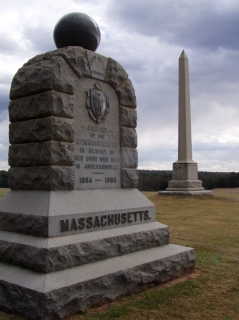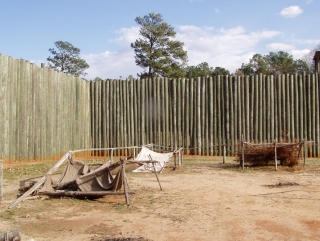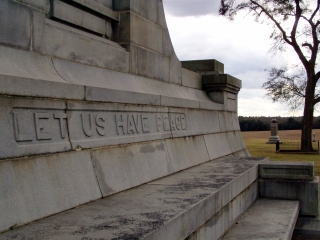Andersonville National Historic Site
Andersonville, Ga.
Visited: December 19, 2004
NPS Site Visited: 130 of 353
NPS Website
 WHAT IS IT? WHAT IS IT?
Site of the infamous Civil War prison camp officially named Fort Sumter but known in the North as Andersonville. The Park also includes the National Prisoner of War Museum.
BEAUTY (3/10)
While in operation, Andersonville was a real life vision of hell, eerily resembling the writhing hell bound bodies of Jan Van Eyck’s The Crucifixon; The Last Judgment or the apocalyptic images of Albrecht Durer. A large drawing of the Prison Camp hangs at the Site drawn years later by a former prisoner from memory. When you look onto the grounds, you can easily imagine the madness. The visual images and history is so disturbing that we often found it difficult to breathe.
HISTORIC SIGNIFICANCE (9/10)
No place demonstrates the insanity of war better than Andersonville NHS.
From February, 1864 until May, 1865 Fort Sumter served as the South’s primary Prison Camp. 45,000 Northern soldiers were held here. 13,000 of those men died at Andersonville. During that time, the Confederacy was in dire trouble. Economic and transportation blockades had effectively removed the South’s ability to feed and clothe themselves. The Confederates could not sustain the living conditions of the Northern POWs while their own people were starving.
The result was one of humankind’s lowest points.
The Andersonville prison was rectangular in shape and only 26˝ acres. Prisoners were thrown in the open-air stockade and left to fend for themselves. No guards, no roof, no clean water source, no medical help, no sanitation, inadequate food and extremely crowded living conditions. The Prison maintained an average of 30,000 soldiers; the soldiers had little room to move. Some built makeshift tents while others slept by boring holes into the ground.
Bandits roamed the grounds stealing whatever property one might have smuggled in or later procured. Suicide was common; many simply stepped into the no-man’s zone near the stockade walls and were shot. The Prison guards were given the same miniscule food rations as the prisoners. Their death rate was nearly the same as those interred.
The drama of brother fighting against brother in the Civil War over philosophical ideals always sounds romantic and proud. Even after visiting the killing fields of Chickamauga and Gettysburg, the war somehow feels civilized despite the history of death. Andersonville removes any of those notions.
 CROWDS (8/10) CROWDS (8/10)
A good number of people joined us on our Ranger-led tour of the grounds. We all were visibly shaken at different times and the constant probing questions fired from all pulled us back into the tour.
EASE OF USE/ACCESS (3/5)
Andersonville can be accessed via a number of winding Georgia roads that branch westward from Interstate 75. All these roads are well marked; you should not have a problem finding the Site.
CONCESSIONS/BOOKSTORE (5/5)
There are two entire bookshelves of Andersonville-specific titles. The store also stocks POW-related books for all American wars.
COSTS (5/5)
The Site is free as are the Ranger talks and the POW Museum.
RANGER/GUIDE TO TOURIST RATIO (4/5)
Plenty of Rangers all armed with a steely resolve and matter of fact, non-emotional look at history.
TOURS/CLASSES (9/10)
Two Ranger-guided walks through the Prison Site leave at 11 and 2 daily. The tremendous talk lasted more than an hour and covered every conceivable aspect of the Prison’s history and life at the Camp. The Ranger was a wellspring of knowledge. We do not know how she can physically talk and learn about such a horrifying place.
The moving National Prisoner of War camp opened in 1998. It begins with an exhibit that explains the rules regarding POW’s established at the Third Geneva Convention in 1949. It is a good start. Multi-media exhibits follow the experience of the American POW from the Revolutionary War up to the Persian Gulf War. There are so many exhibits that the Museum is overwhelming, both in its content and emotional power. Sadly, the Museum glosses over the treatment of Native America POW’s. It forgets to mention the many that either died or were murdered during custody while making a point to mention that during his imprisonment, Geronimo was more of a celebrity than a prisoner.
The Site includes a Prisoner of War Reference Library (available by appointment) and a computer that lets you find the name and personal information for every person imprisoned at Andersonville.
FUN (7/10)
Fun? No. But a moving and an essential visit, yes. The Museum is stellar and the Ranger talks enlightening.
 WOULD WE RECOMMEND? (9/10) WOULD WE RECOMMEND? (9/10)
The only place we have ever visited that felt similar to Andersonville was the Auschwitz-Birkenau Memorial and Museum in Oswiecim, Poland. A place where you see the darkest reaches of human existence. Andersonville NHS is just as difficult a trip, especially because there are no villains. Everything feels so inevitable and so utterly chaotic.
Both the guards and prisoners were reduced to a sub-human existence through exterior forces made unavoidable because of war. We did this to ourselves. We can never allow it to happen again regardless of the situation.
TOTAL 62/80
|